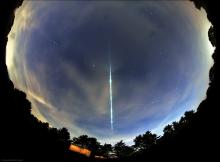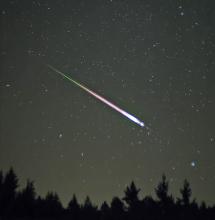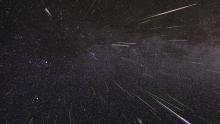Listen to today's episode of StarDate on the web the same day it airs in high-quality streaming audio without any extra ads or announcements. Choose a $8 one-month pass, or listen every day for a year for just $30.
You are here
Orionid Meteors
Earth is running into a celestial sandstorm. We’re plowing into a cloud of dust from Halley’s Comet. That produces a meteor shower — streaks of light across the night sky. Unfortunately, though, the Moon is in the way, so only the brightest of the “shooting stars” will shine through.
This is called the Orionid shower. If you trace the paths of the meteors across the sky, they all converge in the constellation Orion. They can streak across any part of the sky, though, so you don’t have to look at Orion to see them.
The Orionids happen because Earth crosses the path of Halley’s Comet at this time of year. The Sun vaporizes some of the ices on the comet’s surface. As the gases boil into space, they release tiny grains of dirt and rock. Most of these bits are the size of grains of sand or tiny pebbles.
As Earth plows through the comet dust, the particles slam into the atmosphere at up to 150,000 miles per hour.
That extreme speed generates extreme heat, so the particles instantly vaporize — forming meteors. The Orionids aren’t especially bright as meteors go. But they tend to leave glowing trails that remain visible for a few seconds.
The shower should be at its best in the hours before dawn on Tuesday. But it produces some stragglers for weeks before and after that. So if you want to give it a try, find a dark but safe skywatching site, away from city lights. Then scan the sky for Orionid meteors — the result of a cosmic sandblasting.
Script by Damond Benningfield






